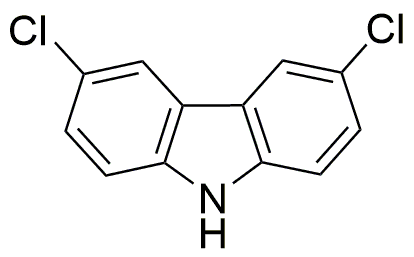3,6-Dichlorocarbazole is widely utilized in research focused on:
- Organic Electronics: This compound is used in the development of organic light-emitting diodes (OLEDs) and organic photovoltaics, providing improved efficiency and stability compared to traditional materials.
- Pharmaceuticals: It serves as a key intermediate in the synthesis of various pharmaceutical compounds, contributing to the development of new drugs with enhanced therapeutic properties.
- Polymer Chemistry: 3,6-Dichlorocarbazole is incorporated into polymer matrices to enhance their electrical conductivity, making it valuable in the production of advanced materials for electronics.
- Research in Photochemistry: It is utilized in studies exploring photochemical reactions, aiding in the understanding of light-induced processes and the development of photonic devices.
- Environmental Science: The compound is investigated for its potential applications in environmental remediation, particularly in the degradation of pollutants due to its reactive chlorine atoms.
General Information
Properties
Safety and Regulations
Applications
3,6-Dichlorocarbazole is widely utilized in research focused on:
- Organic Electronics: This compound is used in the development of organic light-emitting diodes (OLEDs) and organic photovoltaics, providing improved efficiency and stability compared to traditional materials.
- Pharmaceuticals: It serves as a key intermediate in the synthesis of various pharmaceutical compounds, contributing to the development of new drugs with enhanced therapeutic properties.
- Polymer Chemistry: 3,6-Dichlorocarbazole is incorporated into polymer matrices to enhance their electrical conductivity, making it valuable in the production of advanced materials for electronics.
- Research in Photochemistry: It is utilized in studies exploring photochemical reactions, aiding in the understanding of light-induced processes and the development of photonic devices.
- Environmental Science: The compound is investigated for its potential applications in environmental remediation, particularly in the degradation of pollutants due to its reactive chlorine atoms.
Documents
Safety Data Sheets (SDS)
The SDS provides comprehensive safety information on handling, storage, and disposal of the product.
Product Specification (PS)
The PS provides a comprehensive breakdown of the product’s properties, including chemical composition, physical state, purity, and storage requirements. It also details acceptable quality ranges and the product's intended applications.
Certificates of Analysis (COA)
Search for Certificates of Analysis (COA) by entering the products Lot Number. Lot and Batch Numbers can be found on a product’s label following the words ‘Lot’ or ‘Batch’.
*Catalog Number
*Lot Number
Certificates Of Origin (COO)
This COO confirms the country where the product was manufactured, and also details the materials and components used in it and whether it is derived from natural, synthetic, or other specific sources. This certificate may be required for customs, trade, and regulatory compliance.
*Catalog Number
*Lot Number
Safety Data Sheets (SDS)
The SDS provides comprehensive safety information on handling, storage, and disposal of the product.
DownloadProduct Specification (PS)
The PS provides a comprehensive breakdown of the product’s properties, including chemical composition, physical state, purity, and storage requirements. It also details acceptable quality ranges and the product's intended applications.
DownloadCertificates of Analysis (COA)
Search for Certificates of Analysis (COA) by entering the products Lot Number. Lot and Batch Numbers can be found on a product’s label following the words ‘Lot’ or ‘Batch’.
*Catalog Number
*Lot Number
Certificates Of Origin (COO)
This COO confirms the country where the product was manufactured, and also details the materials and components used in it and whether it is derived from natural, synthetic, or other specific sources. This certificate may be required for customs, trade, and regulatory compliance.


